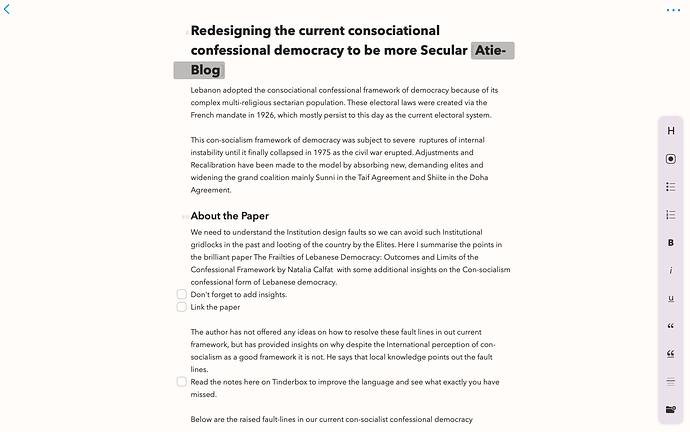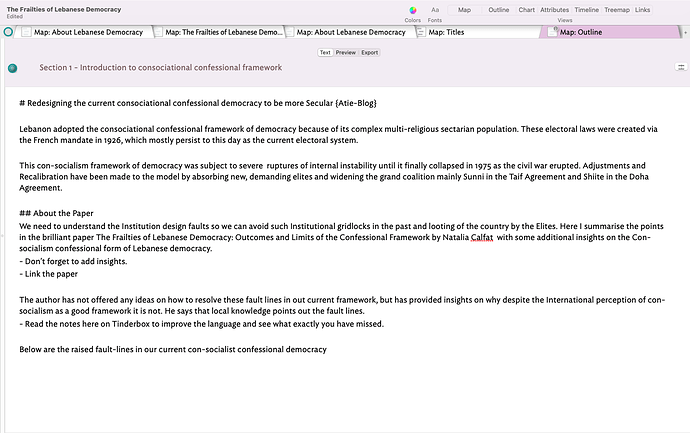This looks like complex workflow. Have you done a video on this? (Just curious)
It is not. All you’d need to do is export out your select notes as individual notes to a share drive.
No, I’ve not.
adding 2 cents
Honestly I don’t use Tinderbox for writing, mostly because quickly extracting information from it feels like getting a root canal done (this may be a pavlovian response to past experiences in exporting), but anyway I do use Tinderbox quite a bit for collecting and understanding.
I have never had the need to write very long manuscripts, but a lot of short ones indeed (think corporate strategies, policies and rules).
My first draft is always in markdown, I don’t want distractions. Later drafts are inevitably done in MS Word, because the rest of the world…
I found invaluable the versioning granularity of Scrivener, which I am not aware any other “word processor” has. I can easily version individual paragraph and revert at will. This is particular useful with policies where you may need to try (and later revert to) more than one version of a paragraph before setting on the final.
For any other writing I use a combination of Drafts or Emacs. They’re both fantastic distraction free, and at the same time super-distracting applications.
I think you’ll find that export has been transformed in recent years. Simple export is now very simple, and even the most complex and demanding export tasks are very practical.
I used to feel this way, but not any more. I’m amazed the the flexibility for all kinds of publishing needs. You’ll find a ton of videos on this topic here: Mastering Tinderbox: Training Videos (Complete List).
Michael - since you pointed to your great series of videos on Tinderbox: will the forthcoming one on Drafts and Tinderbox be the Christmas present to the community? Fingers crossed - so much looking forward to it! 
Michael - I don’t believe it! Many thanks. (If only all my Christmas wishes were fulfilled so speedily!)
Have a merry Christmas, you and your family - and thanks for all you do and keep doing for the Tinderbox community.
Merry Christmas to All and for some good insights on your writing workflow.
I am having the export issues too. But I guess I have opened the another forum post and have to learn it from the experts here. ![]()
Yes please - it helps to split into themed rather than personal issues thereads, not least for later readers. Tinderbox has deep and flexible export, it is a matter of working out what you want. That is, as discrete from just imagining what the output looks like or it looking lie output from [other app], which is the point of view from a lot of us tend to start out (yes, me too, when I started).
I’m sure your fellow users here in the forum can help. ![]()
I haven’t really thought about it. But here is one design change I would recommend to @eastgate to have a focussed mode.
Check the layout (screenshot) in my focussed writing app minimal and then tinderbox. The text should be compact and centred.
You can do this in Tinderbox today: adjust your fonts and your ruler to suit.
Or, view your work in preview, and adopt a stylesheet you like.
Or, if you insist on Markdown, use Tinderbox with Marked2, which is now on sale (as is Tinderbox) as the Artisanal Software Festival https://www.artisanalSoftwareFestival.com/
Hey Mark, I’ve used Marked and it works well when you write your content in one note, but I find it challenging to use when my writing is broken up in chunks across several notes. Is there any way to select multiple notes in Tinderbox, preview them and then edit them as one block (this is a nice feature in Scrivener). That way you can see the whole flow of your writing. Maybe I’m wrong, but I don’t think Marked helps solve this.
You could assemble a composite note from the concatenated texts, and edit that…
I could, and in fact that is what I do, but then I have a versioning issue. I create a Draft composite note. I actually use $Voice to have Tinderbox say nice things to me when I create my draft.  I open the draft it in a Text window and then read it while I edit the original note. I would like to use Marked to Preview the Draft note while I edit my individual notes, but I can’t, as Marked previews the selected note. I don’t edit the composite as that creates a versioning issue with the individual notes.
I open the draft it in a Text window and then read it while I edit the original note. I would like to use Marked to Preview the Draft note while I edit my individual notes, but I can’t, as Marked previews the selected note. I don’t edit the composite as that creates a versioning issue with the individual notes.
To be clear, this is NOT a hue pain for me, but rather a nice to have.
I’m just glad I did mine before LATEX was such a thing. I don’t even know if it existed then but, if it did, my professors didn’t know about it either (1992-1994 approx). There were some really good pre-OSX Mac apps for chemical equations, molecular structures, math formatting, etc., that were far simpler than what we seem to have available now for some reason.
Logging back in after a long absence, a brief data-point here. Context is that I’ve made my living as a writer of books and magazine articles for more than 50 years. ( Recently https://fallows.substack.com/ )
-
For composing any article longer than about 1000 words, or more complex than an op-ed piece or short blog post, I find Scrivener invaluable. It makes organizing ideas, sections, chapters, etc far easier than any other tool I’ve ever used. Eg here is a piece I wrote about it more than a decade ago Interesting Software: More on Scrivener - The Atlantic
-
For keeping track of notes, leads, ideas, themes, reactions, and everything else in that category, I find Tinderbox to be unmatched. I used Lotus Agenda in the MS-DOS era; then Zoot software in the early days of Windows; and for the past dozen-plus years Tinderbox.
YMMV, but that’s my experience.
Revisiting this, the summary—and one with which I’m in accord—is that choices are available and that needs/choices vary and that that variance a good thing. We are all individuals, so one solution cannot fit all.
I also commend @dmrogers’ blog post ‘Distraction’ and the gentle encouragement to not over-focus on the tool (the software) as the ‘problem’ to be addressed when considering our approach to writing.
I write seasonally; that is the tools change as I progress in projects.
Recently, I’m back at Tinderbox, which I use as a kind of lazy man’s zettelkasten—a slip box for my own writing, for my reading notes, for my drafts in progress.
Tinderbox is where I organize, rewrite, edit, link, outline what I’ve worked on, and create structure for what I’ve written—not what I will write. I’ve begun to approach this through bricolage, that is process of improvisation with what I have available. My slip-box has 10,000 notes, and around a million words. Some of this repeated. But, I fly around the document, use search all the time, and the structure emerges in the small corners I’m working on. I make iterative, steady, updates. There are some recent Tinderbox affordances that I really like. In short, my notes live in Tinderbox. For a month, I was doing a lot of first drafts directly in Tinderbox, using zip links to fly around the notes and citations, making connections on the fly.
The last week, I’ve been drafting long hand in GoodNotes on the iPad. (Try it if you have writer’s block. Handwriting recognition is much better today than it used to be. And the slowness of my handwriting, is pleasant as I type to quickly.)
I’ll copy and paste the handwritten notes into Drafts, clean them up, and then file things in Tinderbox.
Over the next few weeks and months, I’ll be organizing, tightening, cutting, and removing redundancy, and working out the structure.
At some point, I might turn to editing small chunks of text. Maybe a 1000 words total./ For this, I use BBedit for to run some text macros, or ProWritingAid and Grammarly to catch typos, repeated words, and other infelicities. I might use linguistic analysis in Ulysses or somewhere else. I note end, I write in markdown, and I’d love a way to copy as plain text, while retaining text links.
But, at the end of the day, that edited section will go back to Tinderbox.
At some point, near the end of the project, when I have more or less a manuscript, I might end up in Scrivener for a few months to do the final editing and polishing. Why Scrivener? Somehow, writing for the printed page (12 point, times new roman, double spaced) gives me a sense of pacing and length of the printer book, in a way that a text window doesn’t. That is, 25 to 30 pages is a chapter. In other words, I like Scrivener’s page view and its ability to edit various notes at once in a kind of stream.
For the kind of writing I do, interpretative social sciences, some of what I write ends up going to peer reviewers, substantive editors, acquisition editors, editor’s assistants, copy editors, proof readers, indexers, and layout people. They all want plain, vanilla word files, with no styling other than bold and italics and footnotes. So, in the end, wherever I am, I end up using panodoc to covert my markdown with markdown footnotes into a word file.
I’ll probably revise in Word few times as well.
For my dissertation, I got all excited about going from Tinderbox to Latex in 2011. It was beautiful but in the end figuring out how to do it was just me procrastinating from acutely writing the dissertation which my supervisor wanted as a word file.
Sometimes, I turn to IA Writer, Highlander, Ulysses, and any number of other markdown editors for fun or full screen. But they are easy to use in tandem with Tinderbox. Select All, Copy, Paste, Command Tab, and I can be in a Full Screen minimalist editor.
But, half my editing I do with a pencil on paper anyway. (Or, maybe an iPad.)
In short, I write in various applications. Each serves a purpose. Tinderbox is a central, versatile tool, which is my Swiss Army knife of notes. For writing, for life.

